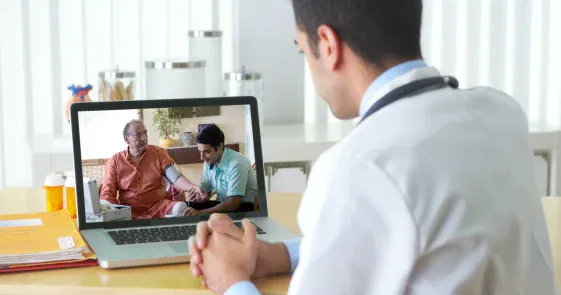In the situation that has arisen because of the COVID19 pandemic, we have reached a stage where teleconsultations have become an unavoidable reality. Many people don’t understand why doctors are reluctant to use teleconsultations. Neophobia, the fear of new things, does exit in medical field as well, but It is not only that. There are genuine reasons also. To know that we need to understand how a doctors diagnose disease and plan a treatment.
How does a doctor diagnose and plan a treatment?
The process of diagnosis involves multiple steps. These are history, inspection, palpation, percussion, auscultation and investigations. Let us understand these one by one.
History taking:
This is the process where the doctor asks you to talk about every detail related to your present illness and past. This is a very important part as the doctor understands what to look for. Very often the patient’s symptom could be a manifestation of a problem in some other organ. This process can happen easily on teleconsultation. So, the history completeness score over teleconsultation would be about 90%. The 10% I am deducting for the rapport that can be developed when done face to face. However, with the masks and barriers, I don’t see that 10% being an problem for now.
General examination:
This is when the doctors looks at your overall health condition like if you are pale or emaciated or have any signs of major illness in general. This also accesses the overall fitness of the patient. This is an important guide in understanding how the patient would tolerate any treatment. I would give a completeness score of 80% for general examination as most of the aspects can be covered on a video call.
Inspection of the area causing problem:
This involves looking at the area that has problem. May not always correspond to the area which patients’ complaints. The many symptoms may be linked to other organs. So, please don’t be surprised if the doctor wants to see abdomen or breast for your problem in neck. Also, position of the patient while this is done and the amount of area to be exposed is very important. That would not be possible on teleconsultation. So, inspection completeness score could be 60%.
Palpation:
This is the term used for feeling the area of problem. Often patient’s think that this is to look for pain. It is not just for that. Your doctors understand many more things from this exercise. This is very import part of reaching a diagnosis and treatment planning. This is impossible to do by telemedicine, so the completeness score is 0%.
Percussion:
Do you remember the doctor tapping on your tummy or chest with one finger? This is called percussion. This helps the doctor to access the content of the mass: air, liquid or solid. This is not possible by tele medicine, so, the score is 0%. However, percussion test may not be needed to be performed in many situations.
Auscultation:
The symbol of a doctor, the humble stethoscope is used for this purpose called auscultation. Doctor listens to your organs like lung, bowel and heart using this. Examination incomplete without this. This is possible to do digitally, but, how will patient figure out where to place a digital stethoscope In correct place while doing teleconsultation would be difficult to say. So, as of now the completeness score is 0%. However, auscultation test may not be needed in many cases.
Investigations:
It is possible to share the reports of all the tests done using various digital platforms. It is possible to completely review the reports and give an opinion based on the reports during teleconsultation. Even the images of CT or MRI scan can be transferred on to cloud platforms and shared with the doctors. This may to some extent offset the need for physical examination as a doctor can us the information instead. So, I would give completeness score of 100%.
Conclusion
Though all the components of examination are important, some may not be relevant to some type of tumors or cancers. So, a video or digital or teleconsultation would be approximately reaching a completeness of 50-90% from case to case. This large range is because of the need of physical examination varies from case to case. For e.g. There is very little information a surgeon would get from examining a patient of oesophageal cancer. For this reason a physical examination is needed only if your doctor says it is needed.

